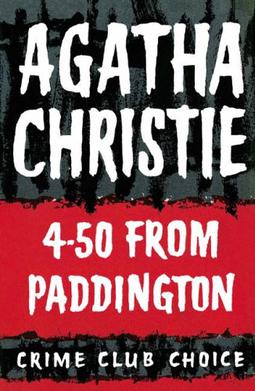Reading the Dame Part4b: The second half of the 1950s
This a continuation of my series of posts about my project to read all 80 somethin
This a continuation of my series of posts about my project to read all 80 somethin
g Agatha Christie mystery books in order of publication (more or less). As usual, this is not just summaries of Christie’s work but my middle-aged musings inspired by reading (or in so
me cases re-reading) these books.
The other parts of the series:
Reading th Dame Part 1: The 1920s
Reading the Dame Part 2a: The 1930s
Reading the Dame Part 2b: The 1930s continued
Reading the Dame Part 3a: The 1940s
Reading the Dame Part3b: The second half of the 1940s
Reading the Dame Part4a: The first half of the 1950s
There are only 5 books in the segment. She has downshifted to publishing just one book a year, a frequency she will keep up until her death, which still almost 20 years way. For this segment she is between the ages of 65 and 69.
As usual my text for each book will discuss the book itself as well as other observations and memories about the book that are not necessarily related to the story.
1955 Hickory Dickory Death
As I read the first page, I felt I had read this one before. Looking at my note inside the front cover, I see I read it back in May 2005, almost exactly 6 years ago, just a few months before my 40th bir
The other parts of the series:
Reading th Dame Part 1: The 1920s
Reading the Dame Part 2a: The 1930s
Reading the Dame Part 2b: The 1930s continued
Reading the Dame Part 3a: The 1940s
Reading the Dame Part3b: The second half of the 1940s
Reading the Dame Part4a: The first half of the 1950s
There are only 5 books in the segment. She has downshifted to publishing just one book a year, a frequency she will keep up until her death, which still almost 20 years way. For this segment she is between the ages of 65 and 69.
As usual my text for each book will discuss the book itself as well as other observations and memories about the book that are not necessarily related to the story.
1955 Hickory Dickory Death
As I read the first page, I felt I had read this one before. Looking at my note inside the front cover, I see I read it back in May 2005, almost exactly 6 years ago, just a few months before my 40th bir
thday. In May of 2005, Maureen and I were living on Passmore Street. I had been working at the Grey Lodge for 11 years and was still taking the el to/from a part time job two days a week. It’s interesting to think about how some things have changed and others have remained the same for me in these 6 years.
Thinking back after reading just the first two pages, I am recallin
Thinking back after reading just the first two pages, I am recallin
g the story and some of the characters. I recall liking this book. It will be interesting to see how I feel after reading this one again.
This is a neat one. It takes place in a hostel for students, many of them foreign. The characters are very well drawn and the plot is very well woven. Having now read this three times, I still have a high opinion of it. Christie has gotten much nicer in her old age. Whereas in the 1920s, the characters would have mildly offensive stereotypes, here the foreign characters are pretty respectfully done.
She focuses again on young people here as she did 3 years earlier in Murder with Mirrors. The young folks here like to go on hitchhiking trips with nothing more than can be kept in a rucksack. Quite a change from her early works, where everyone traveled with heavy luggage.
1956 Dead Man's Folly
I recall reading this one while in hi
This is a neat one. It takes place in a hostel for students, many of them foreign. The characters are very well drawn and the plot is very well woven. Having now read this three times, I still have a high opinion of it. Christie has gotten much nicer in her old age. Whereas in the 1920s, the characters would have mildly offensive stereotypes, here the foreign characters are pretty respectfully done.
She focuses again on young people here as she did 3 years earlier in Murder with Mirrors. The young folks here like to go on hitchhiking trips with nothing more than can be kept in a rucksack. Quite a change from her early works, where everyone traveled with heavy luggage.
1956 Dead Man's Folly
I recall reading this one while in hi
gh school and determining that a folly was a gazebo sort of structure. In this one Poirot is called down to a country estate by mystery writer Mrs. Oliver, a recurring c

haracter. With her woman’s intuition, she suspects something is wrong, and it indeed it is. Mrs. Oliver’s husband has yet to mentioned. All we know is she eats apples, writes mysteries, and changes her hair style a lot. This continues the trend of her reoccurring characters being underdeveloped.
Once again set on an English estate. This estate had been bought by a wealthy man and restored its pre-war glory more or less. The former lady of the estate has been reduced to living in the lodge by the front gate.
Young folks, international students with rucksacks again play a part. The mystery is well constructed and had me guessing right up to the end.
1957 What Mrs. McGillicuddy Saw!
I am almost through this one with Miss Marple. I have only the last chapter let to read and I still can’t figure it out totally. I have a good hunch as to who the murder is, but no motive for the original murder.
She returns to the English country estate again but with a 1950s high taxation twist. This time, the estate is surrounded by a city that has grown up all around it. It’s semi-dilapidated, with no butler, no house maid, just two village women who came in part time, one ancient gardener, and a spi
Once again set on an English estate. This estate had been bought by a wealthy man and restored its pre-war glory more or less. The former lady of the estate has been reduced to living in the lodge by the front gate.
Young folks, international students with rucksacks again play a part. The mystery is well constructed and had me guessing right up to the end.
1957 What Mrs. McGillicuddy Saw!
I am almost through this one with Miss Marple. I have only the last chapter let to read and I still can’t figure it out totally. I have a good hunch as to who the murder is, but no motive for the original murder.
She returns to the English country estate again but with a 1950s high taxation twist. This time, the estate is surrounded by a city that has grown up all around it. It’s semi-dilapidated, with no butler, no house maid, just two village women who came in part time, one ancient gardener, and a spi

nster daughter to act as housekeeper.
Well developed characters and a well constructed ending that had me guessing until the end.
1958 Ordeal by Innocence
A rich woman was murdered. One of her five adopted children was convicted of the crime. He died in jail before he could be cleared of the murder even evidence finally comes out 2 years later. Everything was settled but now everyone is under suspicion again. And with the trail cold, they may all remain suspect forever. Christie remains at the top of her game on this one. . A good number of well developed characters. A plot with a very satisfactory ending. As with many Christie stories there is a happy romantic ending, except in this case three happy romantic endings.
This is neither a Poirot nor a Maple mystery.
1959 Cat Among the Pigeons
I recall reading this one in June of 1982. I was an 8th grader about to graduate, about to put 8 years of St. Jerome’s grade school behind me. It was the final week, classes were done, exams were done. School that week was a leisurely limbo with lots of downtime for reading. Besides my personal memories (which may or may not be accurate), all I remember of this book as I write this before re-reading it is the title and that Poirot is in it.
Now that I’ve read it, turns out I did only remember the title. Maybe I started reading it when I was 13 but got bored and didn’t finish it. At 45, it easily held my attention. As I look back on 40 years of Christie books read over the last 22 months, it’s amazing how many I remember. I would have thought they would start to run into each other.
Christie had mentioned people listening to the radio several times over the years, but this is the first time television gets a mention. She even mentions it twice. I was wondering when this ubiquitous device would become ubiquitous in a Christie story.
I have read 63 of 79 books. Onto the 1960s.
Well developed characters and a well constructed ending that had me guessing until the end.
1958 Ordeal by Innocence
A rich woman was murdered. One of her five adopted children was convicted of the crime. He died in jail before he could be cleared of the murder even evidence finally comes out 2 years later. Everything was settled but now everyone is under suspicion again. And with the trail cold, they may all remain suspect forever. Christie remains at the top of her game on this one. . A good number of well developed characters. A plot with a very satisfactory ending. As with many Christie stories there is a happy romantic ending, except in this case three happy romantic endings.
This is neither a Poirot nor a Maple mystery.
1959 Cat Among the Pigeons
I recall reading this one in June of 1982. I was an 8th grader about to graduate, about to put 8 years of St. Jerome’s grade school behind me. It was the final week, classes were done, exams were done. School that week was a leisurely limbo with lots of downtime for reading. Besides my personal memories (which may or may not be accurate), all I remember of this book as I write this before re-reading it is the title and that Poirot is in it.
Now that I’ve read it, turns out I did only remember the title. Maybe I started reading it when I was 13 but got bored and didn’t finish it. At 45, it easily held my attention. As I look back on 40 years of Christie books read over the last 22 months, it’s amazing how many I remember. I would have thought they would start to run into each other.
Christie had mentioned people listening to the radio several times over the years, but this is the first time television gets a mention. She even mentions it twice. I was wondering when this ubiquitous device would become ubiquitous in a Christie story.
I have read 63 of 79 books. Onto the 1960s.

No comments:
Post a Comment